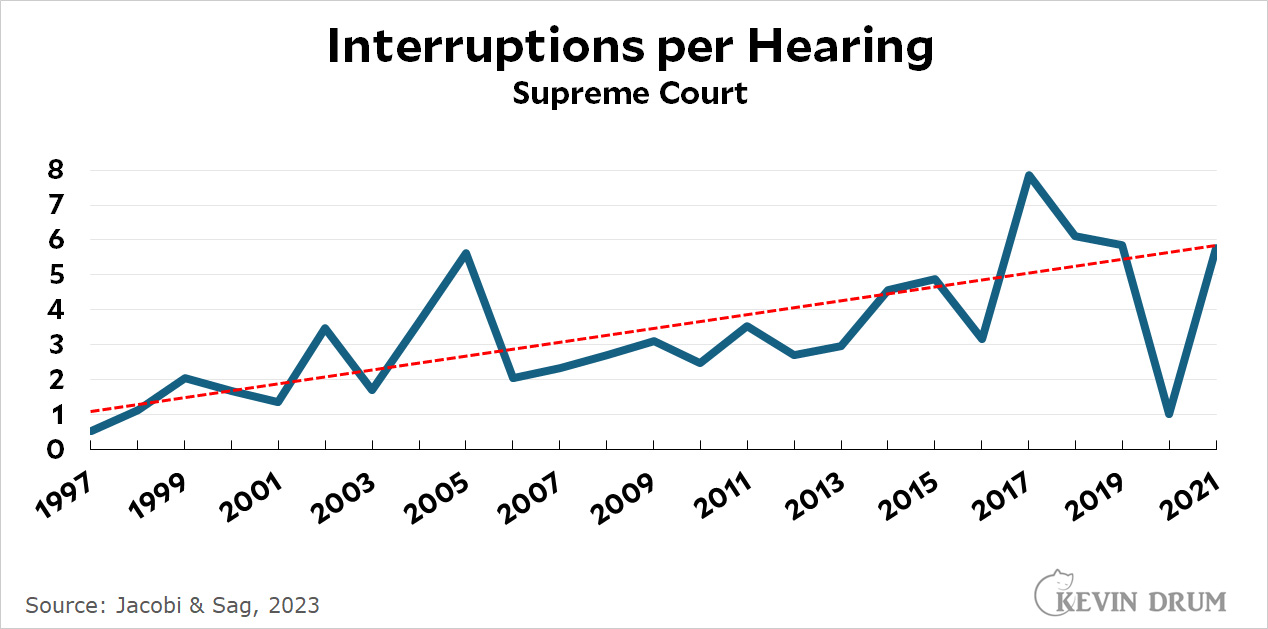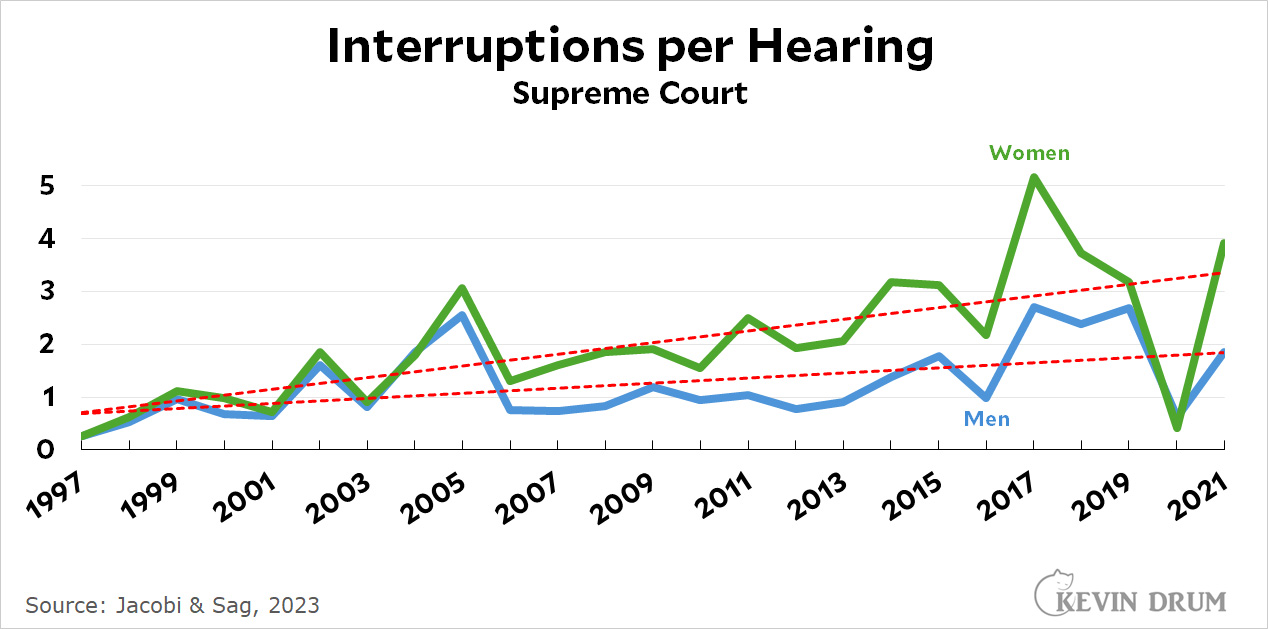Via Kriston Capps, here's an interesting chart from a pair of researchers who have tracked how much Supreme Court justices interrupt each other during hearings:
 The court has gotten steadily testier over the past couple of decades. In 1997 there was about one interruption per hearing. Today it's up to six. Why?
The court has gotten steadily testier over the past couple of decades. In 1997 there was about one interruption per hearing. Today it's up to six. Why?
In addition, you will be unsurprised to learn that it's mostly men doing all the interrupting and mostly women being interrupted:
 The gender difference is pretty much zero through 2005 and then suddenly starts up in 2006. It's been growing ever since. This is all adjusted for the number of women on the court, so it's not related to the fact that there are now more of them.
The gender difference is pretty much zero through 2005 and then suddenly starts up in 2006. It's been growing ever since. This is all adjusted for the number of women on the court, so it's not related to the fact that there are now more of them.
Another oddity is how noisy the data is. For example, in 2016 there's an average of three interruptions per hearing and in 2017 that goes up to eight. Why would that happen over the course of a single year? The justices each speak hundreds of times per term,¹ so it's not just a statistical aberration caused by low sample size. It's a real difference.
Anyway, this is all kind of interesting and hard to explain. Feel free to speculate in comments.
¹Except for Clarence Thomas, of course.

Plot right vs. left, not men vs. women.
The left is 100% female, the right is 83% male, so why do you think plotting right vs. left would be a lot different than men vs women?
The right is not only 83% male, but also 33% credibly charged sexual harassers.
"Another oddity is how noisy the data is."
No it isn't. The total period of time or total number of hearings is irrelevant - if the number of instances of interruption is small the data may look erratic. Statistical measures start to have meaning as the sample size gets larger, that is large numbers of actual instances.
Not just Kevin but the economics media lack an appreciation of how noisy data can be. As I often say, just because somebody comes out with a measure every month doesn't mean that the month/month difference is meaningful.
There are obvious reasons why the number of interruptions might vary such as the political content of the cases considered. It's not just a matter of occurrences which are presumed to be random in time.
Day traders make their money on the noise.
Or lose it!
Good points. From a dude who dealt with noisy data his whole career.
Looking at the personnel, it seems as long as O'Connor and Ginsburg were on the court, there's no pattern. Once Alito replaces O'Connor we start to see the interruption pattern shift.
It's obvious to any rational, that is male, observer that the women are getting more uppity.
Just ask the majority of the dispassionate rational, that is male, Justices.
And the 19th Amendment was wrongly interpreted.
"... This is all adjusted for the number of women on the court, so it's not related to the fact that there are now more of them."
Is it also adjusted for the fact that women talk more? See here :
"At 1628.4 words per argument, Justice Jackson’s average word count is nearly 600 words per argument more than the next most active justice. Her total word count of 78,800 words is greater than 28,000 more words than Sotomayor’s 50,100, which was the second most for a justice across this term. The liberal trio of female justices were the top three most active speakers at oral argument with Justice Gorsuch leading the way for the conservative justices."
and
"Even though the liberal justices make up a third of the Court’s membership, with their large contributions to oral argument they spoke nearly as much as the six conservative justices. ..."
Interesting! That shows nicely how a small sample of 9 individuals (well, plus retired/expired from in this time frame) is not nearly enough to make comments on societal trends etc.
It reminds me of a Women's Studies course I took long ago. A student project collected data on our class of about 50 students and how often men versus women asked questions of our prof. The result was about 53% of the questions were from men, 47% from women. The compounding factor was that I was the only male in that class! A bit embarassing for me when they were presenting their results...
It was the best course I took in at least that semester.
"The gender difference is pretty much zero through 2005 and then suddenly starts up in 2006."
Alito was confirmed in 2006.
Yeah--there are only 9 of these people, and there are generally <100 arguments per year. You could track the data by person, and probably by *who* the person is interrupting, and get a far less opaque picture of what's going on.